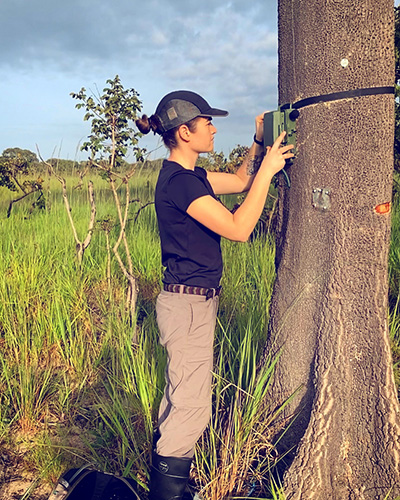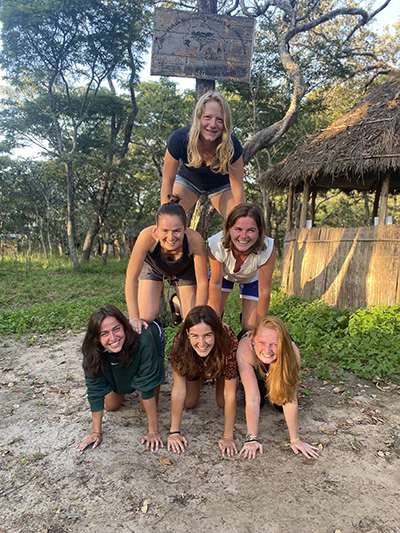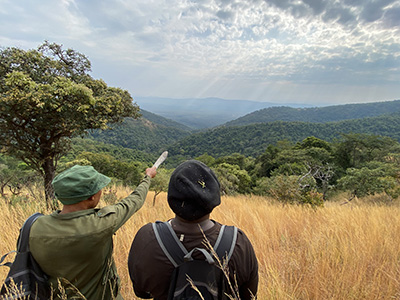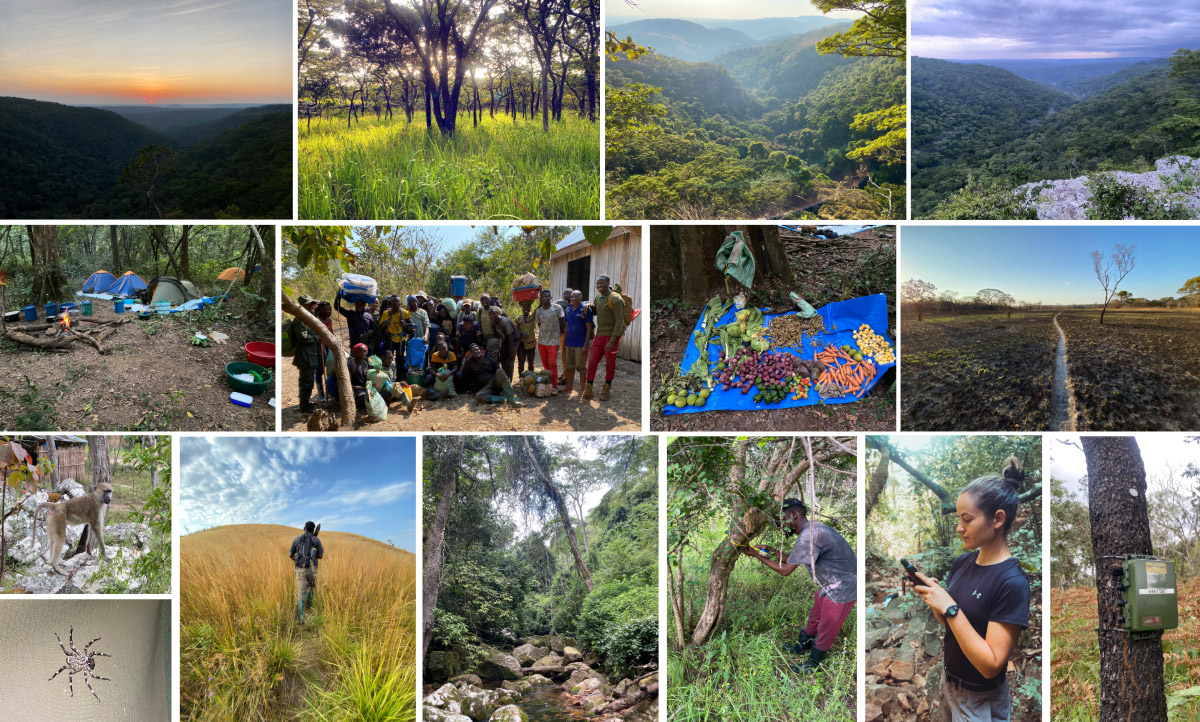FNR Field Report: Ruth Bowers-Sword
Imagine living in a tent in Tanzania, its canvas walls acting as the only barrier between you and the jungle and its wild inhabitants, from chimpanzees to elephants and venomous snakes. Imagine using a cup of cold stream water as your only source of cleansing. Imagine traversing rough terrain, following guides using machetes to cut their way through the dense jungle, and barely being able to communicate with them in their native language.
This isn’t the plot for some new survivalist reality television show, it is just a small glimpse into the summer of 2023 in the life of Ruth Bowers-Sword, a PhD student under Dr. Bryan Pijanowski in the Purdue Department of Forestry and Natural Resources and the Center for Global Soundscapes. Ruth’s research in Tanzania aims to utilize acoustic sensors to effectively assess primate abundance, specifically that of chimpanzees, and determine their geographic distribution and population density. Through passive monitoring and collecting acoustic data 24 hours a day, seven days a week, and comparing that data to traditional methods, she hopes to assist future researchers by utilizing new technologies to make primate conservation more multi-dimensional.
of 2023 in the life of Ruth Bowers-Sword, a PhD student under Dr. Bryan Pijanowski in the Purdue Department of Forestry and Natural Resources and the Center for Global Soundscapes. Ruth’s research in Tanzania aims to utilize acoustic sensors to effectively assess primate abundance, specifically that of chimpanzees, and determine their geographic distribution and population density. Through passive monitoring and collecting acoustic data 24 hours a day, seven days a week, and comparing that data to traditional methods, she hopes to assist future researchers by utilizing new technologies to make primate conservation more multi-dimensional.
“Using acoustics in the world of primatology is a developing technology and there is a distinct gap between technology and innovation and developing conservation strategies within primatology,” Bowers-Sword said. “There are no standardized methods for using acoustics in primatology, and that can be really daunting, especially when you have thousands of hours of data. Primatologists aren't trained to handle that amount of data, so they aren't able to incorporate that kind of technology. But, I believe there are so many ways that it could be beneficial and I would love to help bridge that gap and continue making primate conservation a multi-dimensional, multi-faceted area of study, where you can incorporate different thoughts and technologies.”
Bowers-Sword, a Wisconsin native who completed her undergraduate studies at Lawrence University, a small private liberal arts school, has had many adventures in her life and career, many in the name of career experience and research. After graduating with a degree in environmental studies, Ruth took her interests in anthropology, ecology and GIS into a series of seasonal jobs in order to solidify a career path. She spent a summer completing surveys of endangered frogs in the Sierra Nevada Mountains of California. She worked at Bryce Canyon National Park in Utah. She did invasive species research in the Upper Peninsula of Michigan at Pictured Rocks National Lakeshore.
“I was just trying to get different experiences doing field work and wildlife research, and then in the offseason, in the wintertime, I would look for volunteer positions,” she said.
offseason, in the wintertime, I would look for volunteer positions,” she said.
Her first volunteer experience was as a research assistant for two Purdue Fort Wayne students on Bioko Island, near Cameroon and Equatorial Guinea in west Africa. The five months doing primate research on the island would shape the rest of Bowers-Sword’s professional career.
“All of my other experiences were great experiences, and I learned a lot, but I couldn't really see myself doing them for the rest of my life. After the experience of doing primate research in Africa, I could see myself doing this every day for the rest of my life,” she explained. “This was real people doing primate research. I realized it was not just Jane Goodall up there in the clouds. Everyday people could do that. It was an attainable thing. That is when I decided to pursue my master’s degree.”
Bowers-Sword landed at James Madison University in Harrisonburg, Virginia, where she was co-advised by faculty in the biology and anthropology departments. Ruth’s research involved completing primate surveys and deploying acoustic sensors to assess gun hunting in Cameroon. Her findings showed that acoustic sensors picked up more than 200 gunshots vs. traditional transect surveys which showed only 23 signs of gun hunting, such as spent shotgun shells or gunshots heard.
“That was my first experience using acoustic sensors,” Bowers-Sword said. “There was this huge disparity in what I found doing things the traditional way versus incorporating this new technology. After that research, I decided I wanted to pursue my PhD. I knew that I loved primatology, but I also loved this aspect of innovation and technology and using acoustics to study primates in ways other people weren’t currently doing. I decided to develop the skill of acoustic monitoring rather than finding a program that was specifically for primates.”
Dr. Bryan Pijanowski’s lab at Purdue had just received a grant to begin work on a project funded by NASA to develop a global model of animal and plant diversity. Using acoustic sensors and other remote sensing technologies to monitor biodiversity “sounded really cool” to Bowers-Sword and seemed like “a perfect fit.”
The NASA project specifically focuses on developing plant-animal diversity models for four different types of forested ecosystems, ranging from the deciduous forests in Tippecanoe County to Tanzania’s Miombo Woodlands to Mongolia’s savanna and forest -steppe ecosystems to the mangroves of the Sundarbans in Bangladesh.
In February 2023, Bowers-Sword joined Pijanowski and fellow graduate student “Fran” Rivas Fuenzalida in Bangladesh to maintenance acoustic sensors in the mangroves. During the summer, however, Ruth was on her own completing her research in the Miombo Woodlands.
Bowers-Sword did her research at two habitat sites, first at a permanent research station and the second in a village forest reserve, or a forest that is managed by local villages rather than a government organization.
In addition to deploying acoustic sensors in both locations, Ruth duplicated the traditional methodology of walking transects by setting specific distances, walking them and writing down any sightings, vocalizations, feces, or other signs of chimpanzees. She will later compare the sensor data’s estimate of abundance with the results from traditional methods.
The two research sites were very different in terms of habitat, traversing the landscape, language and companionship.
At the research station, Bowers-Sword was housed with primatologists, students studying primates and other researchers from across the world, and English was the common language. Researchers went out and did their own field work, but returned to camp to eat meals together, etc.
other researchers from across the world, and English was the common language. Researchers went out and did their own field work, but returned to camp to eat meals together, etc.
Trails to and from the research center were named and marked and researchers were constantly coming and going, so traversing from one location to another was simple. Each researcher also was provided with a local Tanzanian field guide, who kept them out of danger and who spoke both Swahili and English.
The chimpanzees at the research center are habituated, or used to having people around, making sightings much more common.
“I had never seen chimpanzees in the wild before,” Bowers-Sword shared. “I did research in Cameroon but there were such high levels of hunting that you never saw the chimpanzees. So, getting to be close to the chimps and seeing them act similarly to how humans would was a surreal experience. And one of the reasons I love doing international work is being able to meet and talk to people from different countries, cultures and societies. I love getting to learn those different perspectives, so getting to meet other researchers from all over the world also was a really amazing experience. To have conversations about primates and be in an environment with other people who were as passionate about primate research as I was, was a really great experience.”
During her four-week stint at the village forest reserve, however, Bowers-Sword encountered several logistical issues. The research collaborator who was originally responsible for setting up the field guides and porters for the location fell ill with malaria, leaving Ruth as team leader to negotiate porter salaries and figure out where the group would be setting up camp in the forest. On top of that, she was the only member of her team that spoke conversational English and Ruth spoke no Swahili.
team that spoke conversational English and Ruth spoke no Swahili.
“I had really good intentions to learn Swahili before I left for Tanzania, but other tasks took priority. I will say that I learned Swahili really well during that immersion experience,” Ruth shared with a laugh. “The two men, called scouts, who were with me while I did my research in the local villages had no prior experience with research or working with foreign researchers, so it was really neat getting to show them my acoustic sensors and explain what they are and what they do. A lot of times, our sensors get broken or stolen because people think that they are cameras or that we are trying to spy on them. It was a really neat experience to be able to explain that I am recording sounds and getting to talk about conservation with them a little bit.”
As she was overcoming the language barrier, Ruth also was faced with traversing the challenging landscape.
“Talk about tough terrain… it isn’t like I was mountaineering up the side of the mountain, but it was very rough terrain at the village forest reserve,” Bowers-Sword said. “It was often easier for us to hike to the top of a mountain and go around to get to a different part of the forest than to try and cut through the forest because it was so thick. I had two guys with me who had machetes trying to bushwhack their way through the vegetation. I remember it took us three hours once to move 100 meters. It was really remote and really physically challenging. I tried to see it as a challenge to overcome, because at the end of the day, I knew I had to do it. I had to go up that mountain or crawl through those thorny bushes. I saw it as more of an empowering challenge that I was ultimately going to succeed in and feel really good about. I liked to think about that light at the end of the tunnel when I was struggling in the moment. There were a lot of internal pep talks to remain self-confident and get through it.”
physically challenging. I tried to see it as a challenge to overcome, because at the end of the day, I knew I had to do it. I had to go up that mountain or crawl through those thorny bushes. I saw it as more of an empowering challenge that I was ultimately going to succeed in and feel really good about. I liked to think about that light at the end of the tunnel when I was struggling in the moment. There were a lot of internal pep talks to remain self-confident and get through it.”
Placing the acoustic sensors to avoid disturbances at the forest reserve without the assistance of technology also tested Bowers-Sword’s knowledge and skills.
“When I was at the research center, I had all of the sites for my sensors predetermined by doing GIS in the lab, but for the village forest reserve, I had no idea where we were setting up camp, so there was no way for me to preemptively plot out where the sensors were going,” Ruth explained. “I had no electricity, no computer, no way to get on GIS once we got to camp to figure out where to deploy my sensors. I literally sat by the fire and drew out diagrams, planning to do two going east one kilometer apart and one north, etc. It was a really cool experience for me to be able to problem solve and think back as if I were in a lab looking at a map of myself right now, where would I put these sensors. When I got back, I was excited to plot the points on a map and see if they matched up with where I had drawn them on my map at camp. That’s real life; that’s field work.”
“You can do all of the prep and planning ahead of time and nothing goes as planned. I had a good solid foundation of what to expect and what not to expect, but every time you go into the field, you learn that you have to be flexible. You just have to prepare the best you can and learn to roll with it. You learn to think on your feet, be independent and trust your intuition that you can overcome literal and non-literal obstacles.”
In addition to the chimpanzees she was studying, Bowers-Sword was able to encounter several other species in the wild.
“I loved seeing all of the primates,” she said. “The chimpanzees are really cool, but I also appreciate the smaller little tree monkeys, which are neat in their own ways. There is a species called the ashy red colobus, which are endangered. They are an underdog monkey that people really don’t know about, but I was able to get some really great videos of them as well as record some really interesting calls, etc. The village forest reserve I was in also had forest elephants, which are actually really dangerous. We didn’t see any, but we came across a ton of elephant poop and the field assistants said they could hear them. I am excited to see if I have any elephant calls on my acoustic sensors.”
Bowers-Sword also experienced the perils and challenges of living in the jungle for three months.
“Snakes were the most common scary thing to come across,” Ruth recalled. “Luckily, since I had field assistant with me, they were always walking ahead of me, while I was monitoring. They would just jump and run if they came across a snake. I learned not to ask questions. If they are running, you are running. There are so many different types of venomous snakes in Tanzania. You don’t wait and take a picture, you jump and run. But, one day, I was in my tent one afternoon just reading my kindle and I heard leaves crunching by my tent. I thought someone was walking up to say something to me. I turned in my tent and there was a five-foot long cobra slithering past, completely unaware that I was there. I just sat there frozen.”
While at the village forest reserve, Bowers-Sword lived in a tent with no phone service or running water.
“It really does become your little home, a little safe space,” Ruth explained. “In general, I am an organized person, so my tent was like my own apartment. This is where I kept my pile of shirts, etc., I think the toughest adjustment was the river bathing. There was just a tiny stream that we had to bathe in. We literally took a cup bath, not even a bucket bath, at the end of every day and it was always freezing and often had tadpoles or little bugs in it. Not having running water or clean water and bathing in a freezing cold stream was a big adjustment. Your clothes are kind of clean, but, honestly, you are just dirty and smelly all of the time and after a while you get used to it. It is part of daily life.”
Bowers-Sword is quick to thank her colleagues in the field, who helped her traverse the ins and outs of Tanzania, both literally and figuratively, from Alex Piel, the faculty member at the University College London who runs the research center in Tanzania, to her personal field assistants at both research locations.
“There’s no way I would have been able to do this project without Alex’s logistical support,” Bowers-Sword said. “If I had questions about something or needed advice, he was really integral support in person for the first two weeks and then over What’s App while I was still in camp. I really admire the way he runs the camp. He tries really hard to involve female local Tanzanians in the work, and, in my experience, it is not often that you have the opportunity to work with female assistants in the field. I have to thank all of the local field assistants, who were so supportive, from not running way ahead of me because I was slow and out of shape, to explaining things to me about being a white foreigner coming into their community and culture and for answering all of the dumb questions I had. There is no way we could do these research projects without local support and without all of the local people who allow us to be there.”
The next step in Bowers-Sword’s research is to utilize machine learning to develop an acoustic detector to extract the chimpanzee calls from the thousands of hours of acoustic data her sensors gathered. She will then compare the data the detector finds to her own assessments from walking transects in both areas in Tanzania to look for any disparities.
Bowers-Sword, who is in her third year as a PhD student, will spend the fall of 2023 and spring of 2024 developing the chimpanzee detector and analyzing her recordings. She will then spend the next year writing her dissertation, with plans to graduate in spring 2025. Ruth’s plans after that are uncertain at the moment, but she intends to follow her passions.
“I haven’t decided whether I want to stay in academia or do something else, but, in general, I would like to work on bridging the gap between finding new technologies and supporting conservation activities,” she said. “I have tried to have an open mind about where the things I enjoy doing may lead me in the future. This experience reminded me of the physicality of field work, but also the rewards of international field work. This solidified the things I am passionate about which will hopefully lead me to employment that I will also enjoy.”
 A collage of images from Ruth Bowers-Sword's summer of research in Tanzania. Top row (Left to Right): the view of a sunrise from the edge of a cliff looking over valley forests of the Issa Valley; a landscape photo of the Miombo woodlands located in the Issa Valley; a landscape photo of the dense forest valleys in the Ntakata forest; a landscape photo from the edge of a cliff looking over a valley forest. Row 2: a temporary camp in the Ntakata forest showing the group's tents and fire/eating area; Bowers-Sword's Ntakata forest team (two field assistants, two local scouts, and the camp cook) along with porters they hired to carry in all of their equipment and supplies to their campsite; all of the fresh food the group packed into the Ntakata forest to their temporary camp (cabbage, green peas, red onions, carrots, peppers, ginger, oranges, avocados, tomatoes); a landscape photo in the Issa Valley of new green grass growing after a wildfire had gone through the area. Row 3: a baboon in the camp at the Greater Mahale Ecosystem Research Conservation camp; a spider on the outside of Ruth's tent at the Greater Mahale Ecosystem Research Conservation camp; Ruth's field assistant walking in front of her as they hike up to the top of a mountain in the Ntakata forest; a photo from the middle of a river at the bottom of a forest valley; a photo of Ruth's field assistant measuring the DBH of a tree for work associated with the NASA project; Ruth holding a GPS while taking a GPS point of a primate encounter while in the Ntakata forest; one of the Pijanowski's lab’s acoustic sensors deployed in the Issa Valley.
A collage of images from Ruth Bowers-Sword's summer of research in Tanzania. Top row (Left to Right): the view of a sunrise from the edge of a cliff looking over valley forests of the Issa Valley; a landscape photo of the Miombo woodlands located in the Issa Valley; a landscape photo of the dense forest valleys in the Ntakata forest; a landscape photo from the edge of a cliff looking over a valley forest. Row 2: a temporary camp in the Ntakata forest showing the group's tents and fire/eating area; Bowers-Sword's Ntakata forest team (two field assistants, two local scouts, and the camp cook) along with porters they hired to carry in all of their equipment and supplies to their campsite; all of the fresh food the group packed into the Ntakata forest to their temporary camp (cabbage, green peas, red onions, carrots, peppers, ginger, oranges, avocados, tomatoes); a landscape photo in the Issa Valley of new green grass growing after a wildfire had gone through the area. Row 3: a baboon in the camp at the Greater Mahale Ecosystem Research Conservation camp; a spider on the outside of Ruth's tent at the Greater Mahale Ecosystem Research Conservation camp; Ruth's field assistant walking in front of her as they hike up to the top of a mountain in the Ntakata forest; a photo from the middle of a river at the bottom of a forest valley; a photo of Ruth's field assistant measuring the DBH of a tree for work associated with the NASA project; Ruth holding a GPS while taking a GPS point of a primate encounter while in the Ntakata forest; one of the Pijanowski's lab’s acoustic sensors deployed in the Issa Valley. 





